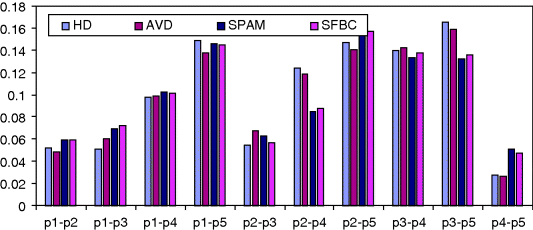25.4 Real Image Experiments
Two real image data sets, the Cuprite data of Figure 1.12 and the 15-panel HYDICE image scene in Figure 1.15, have been used for experiments in previous chapters. Since the experiments in Sections 25.2 and 25.3 have used the AIVRIS data of Figure 1.9 that are derived from the scene in Figure 1.12, this section will only focus on the 15 panels in Figure 1.15(b) and use the 5 panel signatures in Figure 1.16 for experiments. It should be noted that despite that the panel signatures are obtained from real image pixel vectors, the following experiments are performed on the five panel signatures as signature vectors not pixel vectors. Therefore, no sample spectral correlation among pixels is considered in signature coding.
25.4.1 SDFC
Figure 25.24 shows the results of spectral similarity values produced by SPAM, SFBC, HD-SDFC, and AVD-SDFC.
Figure 25.24 Spectral similarity values among p1, p2, p3, p4, and p5 produced by SPAM, SFBC, HD-SDFC, and AVD-SDFC.

Figure 25.25(a) plots comparative results of spectral similarity values of p1, p2, p3, p4, and p5 produced by the four different coding methods, SPAM, SFBC, HD-SDFC, and AVD-SDFC. Once again, there was no clear visual assessment to determine how one coding method performed better than another. RSDPW was calculated for this purpose to further evaluate discriminatory power.
Experiment 25.4.1.1 (R = Average of ...
Get Hyperspectral Data Processing: Algorithm Design and Analysis now with the O’Reilly learning platform.
O’Reilly members experience books, live events, courses curated by job role, and more from O’Reilly and nearly 200 top publishers.

